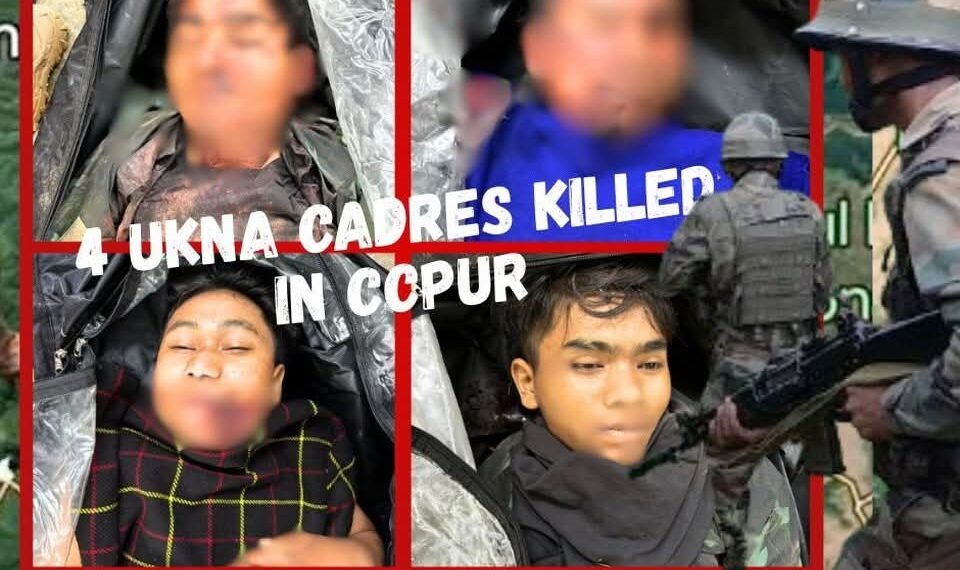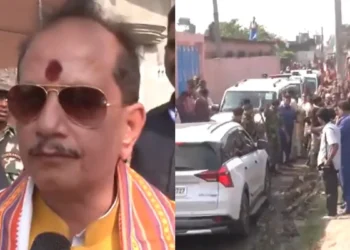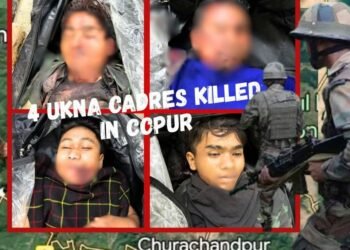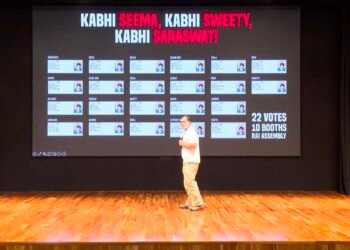From the mayhem of May 3, 2023, to the June 2025 Imphal riots, the pattern is stark: violence in the valley is tolerated, but dissent in the hills is crushed. The state’s double standards now threaten to permanently fracture Manipur’s social fabric.
By Navin Upadhyay
November 5, 2025: The alleged “encounter” in Manipur’s Churachandpur district on November 4 — in which four tribal youths were gunned down by the 21 Para Special Forces — is not an isolated event. It is part of a broader, unsettling pattern in which the Indian state’s coercive machinery seems to act with very different moral and operational standards depending on who stands on the other side of the gun.
The Kuki-Zo Women’s Forum (Delhi & NCR) has condemned the killings as a “brutal and targeted act of militarised oppression.” Eyewitnesses insist that those who died were not armed insurgents but village volunteers — young men defending their homes from continuing ethnic violence. Yet, the official narrative brands them “militants,” a label that now serves as convenient shorthand for any act of lethal force in the hills.
If suspicion alone warrants execution, then every tribal settlement in Manipur could soon become an “encounter zone.”
When Death Danced in Imphal
To understand the fury and grief in Churachandpur, we must return to May 3, 2023, the day ethnic violence first erupted in the Imphal Valley.
When death danced on the streets of Imphal, innocent men and women were dragged out of their homes, lynched, and slaughtered. Houses were set ablaze. Thousands fled for their lives. For three days, Imphal burned.
And yet, the security forces looked the other way. Why?
Why was the violence allowed to continue unchecked for days?
Why was no decisive force deployed to save lives when the first mobs gathered?
The question becomes chillingly relevant now, when we see how security forces in the hills use their guns at the slightest hint of unrest — and how they had none to spare when the killing fields were in the valley.
Selective Fury, Selective Force
In June 2025, when Arambai Tenggol leader Ashem Kanan Singh was arrested, Imphal once again descended into chaos. Arambai Tenggol members and allied Meitei groups rampaged through the capital — attacking police officers, torching vehicles, and defying curfew.
The internet was cut, but not a single protester was shot. The security forces remained restrained — even deferential. No “encounter,” no “crossfire,” no “collateral damage.” When the mobs tired, they went home. The state heaved a sigh of relief and moved on.
Contrast that with March 8, 2025, near Kangpokpi, when Kuki-Zo villagers enforced a blockade demanding safety and justice. Security forces opened fire almost instantly. A tribal youth died on the spot; dozens were injured. The same state that showed restraint in Imphal turned ruthless in the hills.
In December 2024, during a peaceful tribal protest in Saikul, security forces used excessive force in dealing with a mob of protestors A woman protester was left virtually blind after being hit by a rubber bullet.
On June 19, a tribal woman — Hoikholhing Haokip– wife of the village chief of Langchingmanbi in Churachandpur district — was killed on June 19, 2025 during what officials described as cross-fire between security forces and armed men. The post-mortem report was never made public amid allegations that she was shot from close range.
Security forces also killed two women at Churachanpur in the begining of the crisis, and ten hmar boys–alleged militants– at jiribam in November 2024.
Each of these episodes reinforces one truth: when the victims are tribal, the gun is the first resort; when they are valley-based, it is the last.
Assam Rifles Eliminates 4 Kuki Militants In Manipur
4 cadres of the United Kuki National Army (UKNA) killed in an encounter with the Assam Rifles early this morning around 6 a.m. in Churachandpur.
Dead bodies of UKNA Militants were brought to the hospital later. pic.twitter.com/0NHfKouf2w
— India Strikes YT 🇮🇳 (@IndiaStrikes_) November 4, 2025
The Silent Divide of Justice
Why does the state act differently in the hills and the valley?
Is it fear of backlash in Imphal? Or an entrenched prejudice that sees the tribals as disposable citizens?
When Arambai Tenggol looted thousands of weapons in Imphal from police armories in May 2023, there was no crackdown, no mass arrests, no “zero tolerance.” To this day, many of those arms remain unreturned, paraded openly by insurgents.
Meanwhile, the hill districts are treated as occupied zones — subject to suspicion, raids, and sudden violence. Every Kuki-Zo village is a potential hideout; every young man, a “suspect.”
This asymmetry of perception fuels the asymmetry of force. The Churachandpur killings are not just a military episode — they are a political statement. The message is unmistakable: Tribal life is cheap.
READ: Kuki Women’s Forum Alleges Manipur “Encounter” Victims Were Village Volunteers, Not Militants
READ: Opinion: EC Must Reject Rahul’s Charges or Face the Nation’s Scrutiny
Encounters or Executions?
India’s Northeast has lived too long under the Armed Forces (Special Powers) Act (AFSPA), a law that grants sweeping powers to the military, including the authority to shoot to kill on suspicion. Meant to combat insurgency, it has often become a shield for impunity.
The story seldom changes: security forces claim they were fired upon, display a couple of weapons allegedly recovered, and declare victory. Later, survivors tell a different tale — of unarmed men dragged out of their homes and executed.
The state rarely feels the need to explain. After all, they were “suspected militants.”
But suspicion is not guilt, and the right to life is not conditional.
The tragedy of Manipur today is not only the violence but the moral numbness surrounding it. The nation has learned to classify grief. A Kuki-Zo death barely registers.
Television panels go silent; official statements dry up. The normalization of tribal deaths — as if they were inevitable by-products of “law and order operations” — corrodes the moral foundation of the Republic.
Citizenship is meant to be equal. Yet, the people of the hills live as if their rights are suspended, their lives negotiable.
What Justice Demands
The Churachandpur encounter must be investigated through an independent judicial inquiry, not an internal probe. The government must answer:
- What intelligence justified the operation?
- Were the slain men armed?
- Was there provocation or merely suspicion?
- Why were standard procedures on civilian safety ignored?
Accountability cannot be selective. The restraint shown in Imphal must extend to Churachandpur. Otherwise, India risks legitimizing a two-tier justice system — one for the valley, another for the hills.












